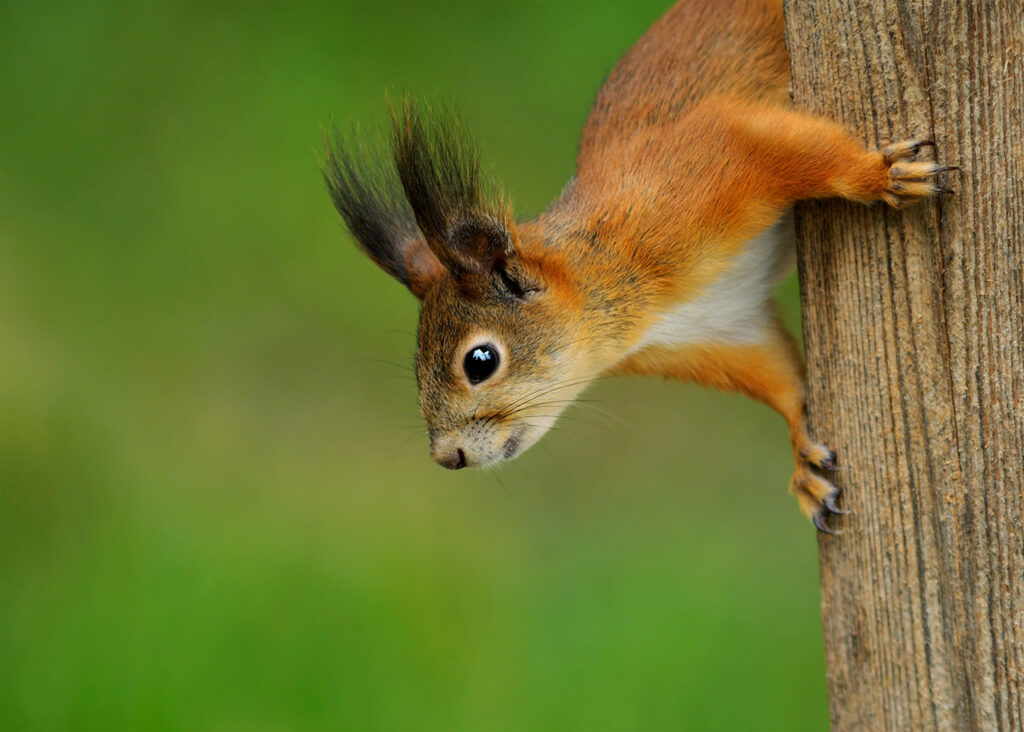Red Squirrel Facts
Red squirrels are most commonly found in the Northern half of North America from the Rocky Mountains up into Quebec. Their mating season happens twice a year — once in the spring from March to May, and again from August until September. Red squirrels live an average of five years in the wild, but can live up to 10 years in captivity.

They enjoy snacking on pine seeds and buds, as well as a variety of nuts like acorns and walnuts. They’ll occasionally eat insects or other small animals. Red squirrels are hoarders and will store two seasons worth of food by hiding it in multiple locations that are moist and cool, like your attic.
Red Squirrel Damage
There are some benefits to having these squirrels around, as they will gather and disperse seeds they never end up eating, increasing biodiversity. If fungi develop in spots where they store their food, like trees, nutrients will be absorbed by surrounding plants. However, they cause a good amount of damage by eating seeds from trees and peeling back the bark.
If they begin to nest indoors, not only will their noises become annoying, but their nests can also create fire hazards if they are blocking vents. If they are in attics or walls, they may chew through wiring, potentially short-circuiting any connected appliances. The same holds true for when they run along power lines, as they can sometimes cause problems with transformers.
Squirrels can also carry a variety of diseases such as mange, cat scratch fever, typhus, and occasionally rabies. Mange affects the fur of the squirrel, causing them to lose their coats. Cat scratch fever will cause pain from swollen lymph nodes. Typhus is a disease that produces rashes on the body, and even delirium. Rabies, although rare, will severely damage the nervous system if it is not caught early on.
Red Squirrel Infestation
Red squirrels are most active during the day, usually in the morning and afternoon. You’ll hear a lot of chatter from these squirrels, as the noises they emit never seem to stop. These calls are loud and birdlike, and sometimes even carry an aggressive tone.
Around your shed or near other nesting sites, you may find small piles of oval-shaped droppings. Red squirrels make nests out of grass, moss, plant matter, bark, feathers, and fur. Red squirrel nests are typically found in holes of trees, under piles of leaves, or even underground.
Red squirrels enjoy a diet of gnawed twigs, stripped nuts, or piles of pine cones, acorns, and other foods around your yard. Your flower bulbs may be eaten, along with any seeds you have laying around. They also love to strip the bark from trees, which they will use in their nests.
If they’ve gotten inside a building, it is possible to see holes in vents, eaves, and soffits. You might also notice claw marks on the side of the building, chewed wires, and damaged household items from their chewing, urine, or droppings.
Types of Red Squirrels
Red Squirrel Identification
Red squirrels can be 12 inches long. As the name implies, they have deep, reddish fur, a white underside, and flatter tails. Red squirrel tails are smaller and less bushy in comparison to other tree squirrels. Their curved claws and strong legs make them excellent climbers and jumpers.
Red Squirrels in the Walls & Home
If your home is in a densely wooded area with a lot of pine trees, then you might snag a look at the red squirrel. These rodents are found mostly in mountainous areas, preferring the shade of trees, as well as the food they can provide. Strongly territorial, red squirrels will protect the areas where they forage for food, as well as their dens.
Frequently Asked Questions
What do red squirrel droppings look like?
Red squirrel droppings are oblong-shaped pellets are around 3/8 inch long and 1/8 inch in diameter. Fresh droppings are dark brown, while old droppings are light brown. If you find droppings in your attack that vary in color, it’s usually a sign that the red squirrels have been there for awhile.
How do you control a red squirrel infestation?
Creating the illusion that food isn’t available is a good place to start if you want to rid your yard of red squirrels. Don’t feed these rodents if they come poking around, and try to eliminate artificial sources of food like bird feeders. It’s possible to buy squirrel-proof containers if you’d still like to see some birds flock to your yard, however always make sure that these areas are clean and free of stray seed.
If they have gotten inside a structure on your property, make sure there are no young squirrels stuck inside. If this is the case, seal any entry and exit points like cracks in the foundation, chimney flues, or holes in siding. Trimming back tree branches may also dissuade the squirrels from jumping on your rooftop and getting inside.
Ultimately, however, having a licensed pest control expert confront the infestation is the safest and surest way of resolving it.
What are the benefits of professional squirrel pest control?
Expert pest specialists have the educational background, equipment, and skill to control and remove wildlife nuisances from a property in a safe, efficient way.
If you’re struggling with squirrels on your property, contact us. Our technicians can remove the rodents and help you regain control of your property and sanity.


